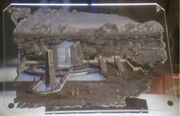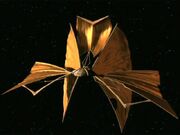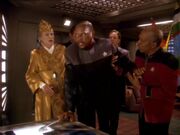Bajoran history is one of the most far reaching in the galaxy, stretching back hundreds of thousands of years. The Prophets influenced much of Bajor's history after their Orbs were found by the Bajorans, who began to worship them as gods.
The most well known period of Bajoran history is the Cardassian Occupation which lasted from the early years of the 24th century to 2369.
Early history

An icon painting of B'hala
Bajoran civilization first began to flourish more than half a million years ago. The ancient Bajorans were renowned for their accomplishments in science, mathematics, philosophy, and the arts long before Humans learned to speak or make tools. Around 20,000 years ago magnificent cities such as B'hala were built on Bajor and the Gratitude Festival was introduced, a tradition which would be continued to the present day. Approximately 10,000 years later, the first of the Tears of the Prophets were discovered above Bajor. These orb-like artifacts ushered in a new era of spiritual connection with the Bajoran gods, the Prophets. Around the same time, Bajoran archaeologists began their search for the famed, and by then lost, city of B'hala. However, the city was not rediscovered until the 24th century. Bajoran religious development also included "prophecies" issued by spiritual writers such as Trakor, who lived approximately 500 BC. (TNG: "Ensign Ro"; DS9: "Emissary", "Fascination", "Prophecy", "Rapture")

Bajoran lightship
By the 16th century, the Bajoran First Republic was established and Bajorans had developed sublight space travel employing solar-sail spacecraft. By using tachyon eddies, some Bajoran explorers even reached the Cardassian system several light years away as it is evidenced by ancient crash sites uncovered on Cardassia by the 24th century. Unknowingly, Bajoran space travelers also made the first observations of the Celestial Temple, a stable wormhole and the home of the Prophets, in their home star system. In the Bajoran year 9174 (around 2172), Akorem Laan, regarded as one of the planet's greatest poets at the time, departed Bajor in a lightship. His vessel was damaged in an ion storm, and drifted into the Denorios Belt, where he opened and entered the yet unknown wormhole and would stay with the Prophets until 2372. Also during the 22nd century, Kai Taluno unknowingly reported a sighting of the wormhole, when his ship was "almost swallowed by the heavens" near the Denorios Belt. (DS9: "Emissary", "Explorers", "Accession")
Despite its high state of development, the Bajoran civilization continued to separate itself into nation-like factions as it is evidenced by the Paqu-Navot Treaty of 2279, which defined the border between two of them. Until the Occupation by Cardassia, Bajoran society also followed a strict system of castes known as D'jarras. It created a clearly stratified social hierarchy by pre-determining each Bajoran's occupation based on his or her family. (DS9: "The Storyteller", "Accession")
The Occupation
- Main Article: Occupation of Bajor

Cardassian station Terok Nor orbiting Bajor during the Occupation
Around 2319, Bajor's neighbor, the imperialistic Cardassian Union, established a military presence on the planet as it considered the Bajoran homeworld to be underdeveloped but rich in natural resources. In 2328, this Occupation of Bajor (or simply called the Occupation) also led to the formal annexation of Bajor by the Cardassians, who claimed to "help and develop" their neighbor. Despite their high state of cultural development, Cardassian technology was approximately 100 years ahead of Bajor, which is why the planet's population surrendered without any serious resistance at first. During the Occupation, the Cardassians perpetrated a coordinated scheme of strip-mining, forced labor, and genocide across the planet and installed the Bajoran Occupational Government, essentially a puppet of the Cardassian Central Command intended to make the occupation look legitimate. In order to keep the Bajorans in line, Central Command also installed a prefect to oversee the planet. The last person to hold this post was the now-infamous Gul Dukat. He euphemistically considered the Bajorans his "children", but in fact oversaw the occupation with an iron fist from his residence on Terok Nor, an orbital ore processing station built by Bajoran slave labor between 2346 and 2351. (DS9: "Emissary", "Babel", "Things Past", "Waltz", "Duet", and more)
Over time, the Occupation gave rise to the fierce Bajoran Resistance, which was organized into small cells operating mostly independently from each other on- and off-Bajor, and using guerrilla as well as terror tactics to eventually force the Cardassians to withdraw. While some noteworthy fighters like Shakaar Edon, Kira Nerys, or Lenaris Holem would become high-ranking officials in the post-occupation Bajoran society, some like Orta would continue to operate out of the legal system. Many Bajorans also fled the occupation and settled on planets all over the known galaxy, but almost everywhere they remained separated from other peoples, living under the poorest circumstances in refugee camps like those on Valo II. (TNG: "Ensign Ro"; DS9: "Emissary", "When It Rains...", et al.)
Independent Bajor
The Bajoran capital city in shambles after the Cardassian withdrawal.
After 50 years of occupation and over 10 million Bajoran casualties, the Cardassians finally withdrew from Bajor in 2369, no longer willing to fight the relentless terrorism of the Bajoran Resistance. The withdrawal was strongly opposed by Gul Dukat, the last prefect of Bajor. In their retreat, the Cardassians devastated Bajoran infrastructure and poisoned vast tracts of farmland, threatening a humanitarian catastrophe. The Bajoran Provisional Government was formed in the wake of the Occupation, but few had confidence that it would survive as internecine conflicts suppressed during the Occupation – such as between the Paqu and Navot nations – soon began to flare again. Kai Opaka, Bajor's religious leader, was instrumental in preventing civil war. One of the first acts of the new government was to issue the Ilvian Proclamation, which exiled all Occupation-era collaborators from Bajor. (DS9: "Emissary", "Cardassians", "The Collaborator")
The Provisional Government requested the assistance of the United Federation of Planets as a protector power and to assist in the rebuilding of Bajor. Both governments established joint control of Terok Nor, a former Cardassian space station orbiting Bajor, which they renamed Deep Space 9. Kai Opaka revealed the station's new Human Commander, Benjamin Sisko, to be the long-awaited Emissary of the Prophets. Ushering in a new era of trade but also strategic importance and danger for the Bajor system, Sisko fullfilled one of the prophecies as Emissary shortly after by (re-)discovering the "Celestial Temple", a nearby wormhole to the Gamma Quadrant, to whose mouth Deep Space 9 was subsequently moved. (DS9: "Emissary", TNG: "Birthright, Part I" et al.)
Vedek Winn and Minister Jaro conspiring in 2370.
However, the alliance with the Federation remained uneasy at first, as many Bajorans, including former resistance groups such as the Kohn-Ma, thought that the interests of the two powers should be kept separate, a sentiment which would be exploited by the Bajoran anti-alien Alliance for Global Unity in early 2370. This Alliance, also known as the "Circle", was secretly supported by high-ranking officials like Minister Jaro Essa and Vedek Winn Adami and denounced the Federation presence aboard Deep Space 9 as another form of occupation. The Circle even attempted a full-scale coup d'etat in what was later discovered to be an elaborate Cardassian attempt to reclaim Bajor by ousting the Federation. (DS9: "Past Prologue", "In the Hands of the Prophets", "The Homecoming", "The Circle", "The Siege")
The Bajor-Cardassia Treaty was negotiated in 2371.
After this incident, the Bajoran political situation stabilized despite some internal power struggles due to Winn Adami's ongoing strife for more power. After Kai Opaka went missing in the Gamma Quadrant in mid-2369, Winn became the new Kai in 2370 by blacken and ousting her favored rival candidate Vedek Bareil Antos. Exploiting Bareil's loyalty to the Kai, Winn also tried to take credit of taking first steps towards normalizing the relationship with the Cardassian Union when she falsely claimed to have negotiated the Bajoran-Cardassian Treaty of 2371 by her own. Kai Winn's attempt to become First Minister of the Provisional Government in addition to her position as religious leader of Bajor was unsuccessful, however. Instead, the popular former Resistance fighter Shakaar Edon ascended to that post in late 2371, thereby preventing Winn Adami from uniting these two most important positions in her person. (DS9: "Battle Lines", "The Collaborator", "Life Support", "Shakaar")

The Emissary of the Prophets prevents Bajor from joining the Federation in 2373.
Bajor's petition for Federation membership was accepted in 2373. However, on the eve of the signing ceremony on Deep Space 9 the Emissary of the Prophets received a series of pagh'tem'far predicting disaster for Bajor unless it stood alone. As a result, the Chamber of Ministers voted to delay acceptance of Federation of membership. As the Dominion War loomed later that year, the Emissary's intervention allowed Bajor to sign a nonaggression pact with the Dominion, ensuring Bajoran neutrality. This saved Bajor from coming under foreign occupation when the Dominion captured Deep Space 9 at the onset of the war. (DS9: "Rapture", "Call to Arms")
In the first months of the Dominion War, Bajor was cut off from all interstellar trade, leading to economic hardship and supply shortfalls. With no one else to turn to, the Provisional Government allowed the Dominion to send 400 Vorta facilitators to Bajor to provide technical assistance. Soon after, the Cardassians gifted fifteen industrial replicators to Bajor as a gesture of friendship. The Bajorans also gained a voice on Deep Space 9 through Odo's presence on the station ruling council. These events were controversial amongst the Bajorans, many of whom feared that they legitimized the Dominion presence in the system and would lead to the erosion of Bajoran sovereignty. Protestors such as Vedek Yassim openly denounced cooperation with the Dominion, and eventually a resistance movement arose on Deep Space 9. (DS9: "Rocks and Shoals", "Sons and Daughters", "Behind the Lines")
The Bajorans joined the war against the Dominion after the Federation Alliance recaptured Deep Space 9 during Operation Return. In early 2375, the Provisional Government granted the Romulans permission to build a military hospital on the uninhabited Bajoran moon Derna. However, an attempt by the Romulans to arm the hospital with plasma torpedoes precipitated a crisis among the Allies. The Bajorans blockaded Derna and demanded that the Romulans remove the weapons, nearly leading to hostilities until Senator Cretak relented under Federation pressure. Following the war, Bajor resumed its efforts to join the United Federation of Planets. (DS9: "Favor the Bold", "Sacrifice of Angels", "Image in the Sand", "Shadows and Symbols", "What You Leave Behind")
Appendices
See also
Apocrypha
In the video game Star Trek Online Bajor's renewed application to join the Federation was accepted in 2384. In 2392 a Bajoran candidate was considered an outside choice in the Federation presidential race. Bajor attained full membership in 2393.
